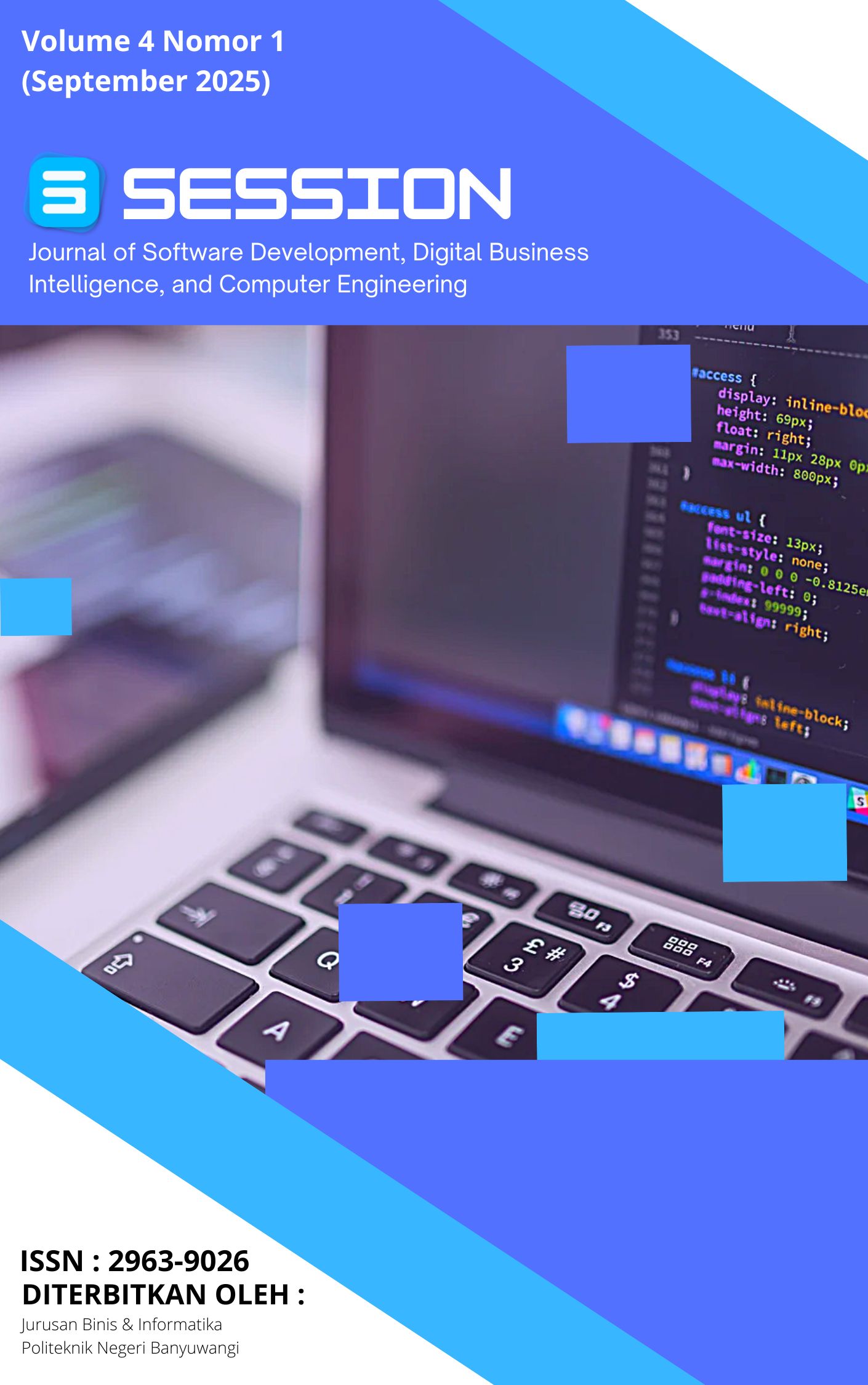Robot Pengikut Objek Menggunakan Deteksi Warna Berbasis Smartphone Android dengan Kendali PID
DOI:
https://doi.org/10.57203/session.v4i01.2025.16-24Kata Kunci:
Robot Pengikut Objek, Deteksi Warna, Smartphone Android, OpenCV, Kendali PIDAbstrak
Robot pengikut objek merupakan salah satu topik penelitian populer karena berbagai implementasi teknologi baru dan manfaat-manfaatnya di masyarakat. Di sisi lain, smartphone sekarang ini memiliki keunggulan-keunggulan sebagai perangkat elektronik yang memungkinkannya digunakan sebagai media pengembangan robot. Penelitian ini berusaha mengembangkan robot pengikut objek yang menggunakan smartphone sebagai pendeteksi objek dan pengolah data pengendali dengan konsep pengendali PID untuk di mengatur robot empat roda yang digerakkan dengan Arduino Uno dan L293D motor driver. Sistem mendeteksi objek berdasarkan warna yang diimplementasikan dengan library OpenCV. Objek yang berhasil dideteksi akan menghasilkan lingkaran pelingkup yang memiliki diameter dan titik tengah. Diameter digunakan sistem untuk menghitung isyarat pengendali translasi, sedangkan posisi titik tengah digunakan untuk menghitung isyarat pengendali rotasi. Beberapa pengujian dilakukan pada robot yaitu pengujian deteksi objek, pengujian gerak translasi, pengujian gerak rotasi, dan pengujian gerak gabungan. Berdasarkan pengujian yang dilakukan, sistem robot yang telah dikembangkan berhasil mengikuti objek berwarna dengan menggunakan nilai-nilai koefisien pengendali PID yang tepat. Namun, terdapat dua kekurangan robot yaitu deteksi objek yang sangat dipengaruhi oleh pencahayaan dan perlunya mencari nilai-nilai koefisien pengendali yang tepat.
Referensi
[1] D. R. Palupi, D. Syauqy, and A. S. Budi, “Object Following Robot berbasis Pembacaan Jarak menggunakan Metode PID Controller,” Jurnal Pengembangan Teknologi Informasi dan Ilmu Komputer, vol. 4, no. 7, Art. no. 7, Aug. 2020.
[2] R. Wahrini, “Development of Color-Based Object Follower Robot Using Pixy 2 Camera and Arduino to Support Robotics Practice Learning,” Jurnal Edukasi Elektro, vol. 7, no. 2, Art. no. 2, Nov. 2023, doi: 10.21831/jee.v7i2.64413.
[3] M. I. Ramadhan, D. Purwanto, H. Kusuma, and H. Kusuma, “Sistem Pengikut Manusia pada Robot Servis Menggunakan Model YOLO dan Kamera Stereo,” JTITS, vol. 12, no. 3, pp. A194–A201, Dec. 2023, doi: 10.12962/j23373539.v12i3.118869.
[4] A. Sadiyoko, A. Fahrunasa, and T. M. Rahayu, “Perancangan Robot Pengikut berbasis Visual dan Kontrol Logika Samar,” ELKOMIKA: Jurnal Teknik Energi Elektrik, Teknik Telekomunikasi, & Teknik Elektronika, vol. 12, no. 1, Art. no. 1, Jan. 2024, doi: 10.26760/elkomika.v12i1.106.
[5] M. Amangesti, D. Puspita, S. Sulaeman, and M. C. Rijal, “Rancang Bangun Troli Pengikut Objek Otomatis,” SNTEI, vol. 9, no. 1, Art. no. 1, Nov. 2023.
[6] B. P. S. Indonesia, “Proporsi Individu yang Menguasai/Memiliki Telepon Genggam Menurut Provinsi - Tabel Statistik.” Accessed: Aug. 06, 2024. [Online]. Available: https://www.bps.go.id/id/statistics-table/2/MTIyMSMy/proporsi-individu-yang-menguasai-memiliki-telepon-genggam-menurut-provinsi.html
[7] W. A. Salah, A. A. Sneineh, and A. A. A. Shabaneh, “Smartphone Sensor-based Development and Implementation of a Remotely Controlled Robot Arm,” Journal of Robotics and Control (JRC), vol. 5, no. 4, Art. no. 4, Jun. 2024, doi: 10.18196/jrc.v5i4.21987.
[8] Y. S. Handayani and Y. Mardiana, “KENDALI ROBOT BLUETOOTH DENGAN SMARTPHONE ANDROID BERBASIS ARDUINO UNO,” ILKOM Jurnal Ilmiah, vol. 10, no. 3, Art. no. 3, Dec. 2018, doi: 10.33096/ilkom.v10i3.363.331-337.
[9] W. Purbowaskito and C.-H. Hsu, “Sistem Kendali PID untuk Pengendalian Kecepatan Motor Penggerak Unmanned Ground Vehicle untuk Aplikasi Industri Pertanian,” JURNAL INFOTEL, vol. 9, no. 4, Art. no. 4, Nov. 2017, doi: 10.20895/infotel.v9i4.253.
[10] M. Lamatenggo, I. Wiranto, and W. Ridwan, “Perancangan Balancing Robot Beroda Dua Dengan Metode Pengendali PID Berbasis Arduino Nano,” Jambura Journal of Electrical and Electronics Engineering, vol. 2, no. 2, Art. no. 2, Jul. 2020, doi: 10.37905/jjeee.v2i2.6906.
[11] F. F. W. Amaral, J. Subur, and S. Suryadhi, “Implementasi Metode PID dan Inverse Kinematics pada Pergerakan Robot Berkaki Enam (Hexapod),” SinarFe7, vol. 6, no. 1, Art. no. 1, Sep. 2024.
[12] “Arduino Uno Rev3,” Arduino Official Store. Accessed: Apr. 14, 2025. [Online]. Available: https://store.arduino.cc/products/arduino-uno-rev3
[13] “ATMEGA328P.” Accessed: Apr. 14, 2025. [Online]. Available: https://www.microchip.com/en-us/product/atmega328p
[14] bharat, “From Healthcare to Automotive: Exploring OpenCV Applications in 2025,” OpenCV. Accessed: Apr. 15, 2025. [Online]. Available: https://opencv.org/blog/opencv-applications-in-2023/
[15] A. A. M. Suradi, M. F. Rasyid, M. Mushaf, and M. Rizal, “Deteksi Tingkat Kematangan Buah Apel Menggunakan Segmentasi Ruang Warna HSV,” SISITI : Seminar Ilmiah Sistem Informasi dan Teknologi Informasi, vol. 12, no. 1, Art. no. 1, Feb. 2023, doi: 10.36774/sisiti.v12i1.1163.
[16] S. Jardim, J. António, and C. Mora, “Image thresholding approaches for medical image segmentation - short literature review,” Procedia Computer Science, vol. 219, pp. 1485–1492, Jan. 2023, doi: 10.1016/j.procs.2023.01.439.
[17] R. P. Borase, D. K. Maghade, S. Y. Sondkar, and S. N. Pawar, “A review of PID control, tuning methods and applications,” Int. J. Dynam. Control, vol. 9, no. 2, pp. 818–827, Jun. 2021, doi: 10.1007/s40435-020-00665-4.
Unduhan
Diterbitkan
Terbitan
Bagian
Lisensi
Hak Cipta (c) 2025 Indra Kurniawan, Arif Fahmi

Artikel ini berlisensi Creative Commons Attribution 4.0 International License.
Copyright :
Authors who publish their manuscripts in this journal agree to the following conditions.
- The copyright on each article belongs to the author(s).
- The author acknowledges that Jurnal SESSION: Software Development, Digital Business Intelligence, and Computer Engineering has the right to be the first to publish with a Creative Commons Attribution 4.0 International license (Attribution 4.0 International (CC BY 4.0).
- Authors can submit articles separately, arrange for the nonexclusive distribution of manuscripts that have been published in this journal into other versions (e.g., sent to the author's institutional repository, publication into books, etc.), by acknowledging that the manuscript has been published for the first time in the Jurnal SESSION: Software Development, Digital Business Intelligence, and Computer Engineering.
License:
![]()
Jurnal SESSION: Software Development, Digital Business Intelligence, and Computer Engineering is licensed under a Creative Commons Attribution 4.0 International License.
This license permits anyone to copy and redistribute this material in any form or format, compose, modify, and make derivatives of this material for any purpose, including commercial purposes, as long as the author credits the original work.








